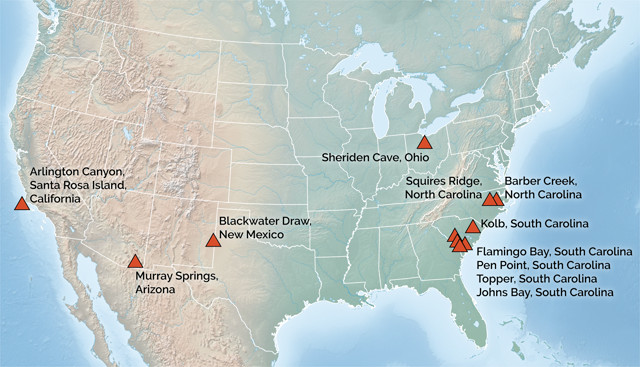Platinum may point to impact theory for Younger Dryas
by Mary Caperton Morton
Friday, June 16, 2017

Archaeologists found an abundance of platinum — an element that can be associated with cosmic objects like asteroids or comets — at 11 Clovis excavation sites across the United States. Credit: K. Cantner, AGI.
Some large meteorite strikes leave obvious craters on Earth’s surface, while others that hit water or ice or explode in the air may only leave subtle markers in the soil, such as exotic minerals or elevated levels of rare elements like platinum or iridium. In a newstudy, researchers report spikes of platinum in sediments at archaeological sites across North America, offering new evidence, they suggest, of a major meteorite strike about 12,800 years ago, just before the onset of a global cold period known as the Younger Dryas. The lack of a telltale crater dating to this time, however, has left scientists debating for years whether an impact actually occurred and what, if any, role it had in setting off the cold snap and affecting some of Earth’s human and animal populations.
The Younger Dryas lasted from about 12,800 until 11,700 years ago, with temperatures abruptly dropping by as much as 6 degrees Celsius across the Northern Hemisphere. This period saw what some archaeologists interpret as declines in human and megafauna populations across North America. “There is some circumstantial evidence that there may have been a population decline among the Clovis people [in North America] during this cooling period,” saysChris Moore, an archaeologist at the University of South Carolina and lead author of the new study, published in Scientific Reports. Megafauna, such as woolly mammoths, may also have been declining for some time, though many scientists attribute the animals' eventual extinction, in part, to overhunting.
Since 2007, several studies have found evidence in ice and buried sediments for an extraterrestrial impact at the onset of the Younger Dryas, including high concentrations of platinum, nanodiamonds and rocky microspherules that aren’t commonly found in abundance on Earth. In 2013, astudypublished in Proceedings of the National Academy of Sciences that looked at ice cores in Greenland found a platinum concentration spike dating to this time. “The most likely interpretation is that the platinum is not terrestrial and came from the sky [aboard a meteorite],” saysMisha Petaev, a geochemist at Harvard University and lead author of the 2013 study.
In the new study, Moore and his colleagues identified similar platinum signatures at archaeological sites in California, Ohio and other states in the Mid-Atlantic and Southwest. “We surveyed archaeology sites because the [sediment] layers are well-dated and it was possible to pinpoint this time period 12,800 years ago,” Moore says. “We found this platinum anomaly in virtually every site we tested, right where it should be: at the onset of the Younger Dryas.”
“The evidence [presented in this new study] is a continuation of what we’ve been finding every time we look for an impact,” saysRichard Firestone, a physicist at Lawrence Berkeley National Laboratory in Berkeley, Calif., who was not involved in the new study. “People can argue about how important the impact was to extinction events and human populations, but the timing of this event with the onset of the Younger Dryas is really spot on.”
No single crater has been conclusively tied to this time period, but Firestone says that’s not surprising. “Whatever this event was, it was clearly something that impacted a lot of places around the world. It might not have been a single dense object, but rather a cluster of objects that struck in multiple places.” The object, or objects, may have also struck water or ice, thus leaving no craters, or the craters could have already been filled in or weathered and eroded away.
But without a well-dated crater to point to, many scientists are still skeptical about the Younger Dryas impact theory. The theory “has been really controversial since it was first proposed,” Moore says. “The evidence keeps mounting, but some people just won’t accept the idea. It’s still very hotly contested.”
Mark Boslough, an impact physicist at Sandia National Laboratories in Albuquerque, N.M., says he remains unconvinced that a large impact occurred at the beginning of the Younger Dryas. “The working hypothesis [for the impact theory] is always changing. Sometimes it’s an airburst, sometimes it’s an exploding comet that struck many different places, sometimes it’s a single impact that hit ice or water,” Boslough says. “I am all for having multiple working hypotheses but you need to limit them to those that are physically possible and consistent with the evidence,” he says. In short, he says it’s unlikely that an impact that left no crater could have had climate consequences globally, but if something big did hit ice or water — explaining why there is no crater — it would have produced copious steam, but not the shocked minerals or nanodiamonds that previous studies have claimed as evidence for an impact. Regarding the newly described platinum anomalies across the U.S., Boslough says he’s awaiting independent confirmation of the results by other researchers.
Moore says he hopes the work inspires other archaeologists to survey additional sites thought to date to the same time for platinum anomalies, which involves a relatively easy and inexpensive test. “Even if you don’t believe there was a comet impact, this platinum layer could be a useful chronographic marker for geoarchaeological research,” he says. “It could be used to identify potential Clovis sites, since they are often found right below this platinum horizon.”
